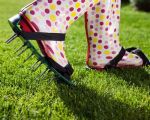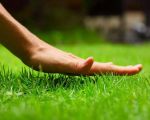
- Understanding-Summer-Lawn-Care
- Proper-Watering-Techniques
- Summer-Fertilization-Best-Practices
- Mowing-Strategies-for-Heat
- Weed-and-Disease-Management
- Real-Life-Examples-for-Summer-Lawn-Care
- Where-to-Find-Professional-Lawn-Care-Services
1. Understanding Summer Lawn Care
Summer presents unique challenges for maintaining a lush, green lawn. Higher temperatures, increased sunlight, and often sporadic rainfall can stress grass and make it vulnerable to damage. To protect your lawn during the hot months, it’s important to adjust your lawn care routine to meet the specific demands of summer. The foundation of effective summer lawn care is balancing water, nutrients, and mowing practices while preventing common summer lawn problems like weeds and diseases.
Different grass types react differently to summer stress. For example, cool-season grasses such as Kentucky bluegrass and fescues may go dormant or brown if not cared for properly, while warm-season grasses like Bermuda and Zoysia thrive in heat but still require attention. Understanding your grass type is essential to applying the right summer lawn care tips effectively.
1.1 The Impact of Summer Stress on Lawn Health
Summer heat can cause lawns to dry out quickly, weakening root systems and making them more susceptible to pests and diseases. Drought stress reduces the lawn’s ability to absorb nutrients, which can result in dull, patchy turf. The key to overcoming these challenges is proactive and informed care, starting with watering and fertilization tailored for summer conditions.
2. Proper Watering Techniques for Summer
Watering your lawn in summer is more than just turning on the sprinkler. Overwatering or watering at the wrong time can lead to shallow roots and disease. Experts recommend watering deeply and infrequently to encourage strong root growth.
2.1 Best Time to Water
Early morning, ideally between 4 a.m. and 10 a.m., is the best time to water your lawn. This reduces evaporation loss and allows the grass to absorb moisture before the day heats up. Avoid watering in the evening to minimize prolonged moisture on the grass blades, which can lead to fungal diseases.
2.2 How Much Water Does Your Lawn Need?
During the summer, lawns typically require about 1 to 1.5 inches of water per week, including rainfall. Using a rain gauge or a simple container to measure sprinkler output can help ensure your lawn gets enough water without wasting resources.
3. Summer Fertilization Best Practices
Fertilizing your lawn in summer needs a careful approach. Too much fertilizer, especially high in nitrogen, can burn your lawn under the intense heat.
3.1 Choosing the Right Fertilizer
Look for fertilizers formulated for summer use with a balanced nutrient ratio that supports root growth and stress tolerance rather than rapid blade growth. Slow-release fertilizers are ideal as they provide nutrients gradually, reducing the risk of fertilizer burn.
3.2 Timing and Application
Applying fertilizer in early summer, before the hottest period, can boost your lawn’s vigor. Avoid fertilizing during peak heat or drought conditions. Also, consider soil testing to tailor your fertilizer use to the actual nutrient needs of your lawn.
4. Mowing Strategies During Hot Weather
Mowing your lawn correctly in summer can reduce stress on grass and improve its resilience.
4.1 Adjust Mower Height
Raise the mowing height during summer to leave the grass longer—about 3 to 4 inches depending on grass type. Taller grass shades the soil, reduces evaporation, and strengthens roots. Cutting more than one-third of the blade length at a time should be avoided to prevent shock.
4.2 Mowing Frequency
Depending on growth rates, mowing once a week or even less frequently during extreme heat is sufficient. Leaving clippings on the lawn acts as a natural mulch, returning nutrients and helping retain moisture.
5. Weed and Disease Management in Summer
Weeds often take advantage of stressed lawns during summer. Effective weed control combined with disease prevention is crucial for a healthy lawn.
5.1 Integrated Weed Control
Maintaining a dense, healthy lawn through proper mowing, watering, and fertilization helps prevent weeds from taking hold. For existing weeds, spot treatments with appropriate herbicides can be applied carefully to avoid damage to the lawn.
5.2 Preventing Common Summer Lawn Diseases
Diseases like brown patch and dollar spot thrive in hot, humid conditions. Good lawn hygiene—such as removing thatch buildup, avoiding overwatering, and proper air circulation—helps minimize disease risks. If symptoms appear, early treatment with fungicides is advisable.
6. Real-Life Examples and Stories
Consider the story of a homeowner in the southern United States who struggled with a patchy, drought-stressed lawn each summer. After consulting lawn care professionals, they adopted a deep-watering schedule, raised their mower height, and switched to a slow-release fertilizer designed for summer use. Over two seasons, their lawn transformed into a thick, resilient carpet of grass, even during heat waves.
Another example comes from a golf course superintendent who implemented a precise watering and fertilization program targeting summer stresses. By carefully monitoring soil moisture and adjusting fertilizer timing, the course maintained exceptional turf quality all summer, improving player satisfaction and reducing maintenance costs.
7. Where to Find Professional Lawn Care Services
While many summer lawn care tips can be managed by homeowners, sometimes the best results come from professionals who understand local conditions and grass types. For customized advice, equipment, and services like fertilization, weed control, and disease management, Lawn Care Services offers tailored solutions to help you achieve and maintain the perfect summer lawn. Their expert team can guide you through best practices and provide high-quality products designed specifically for your lawn’s needs.








